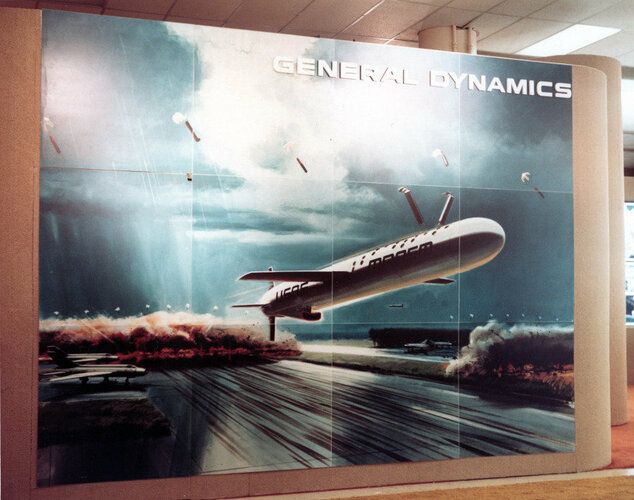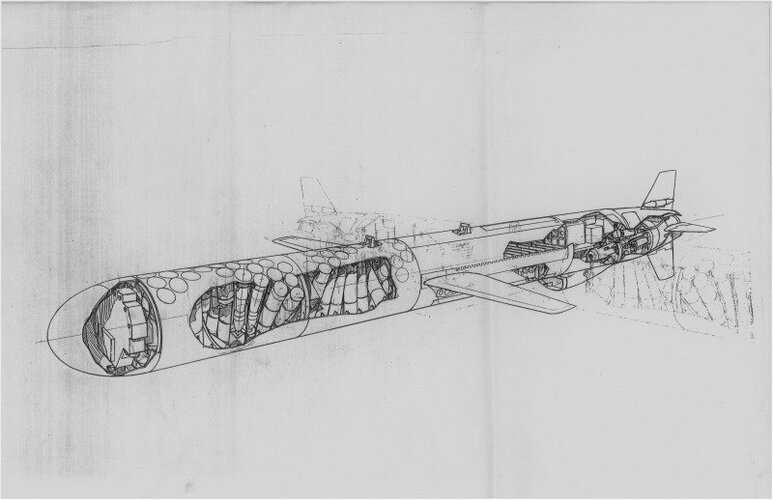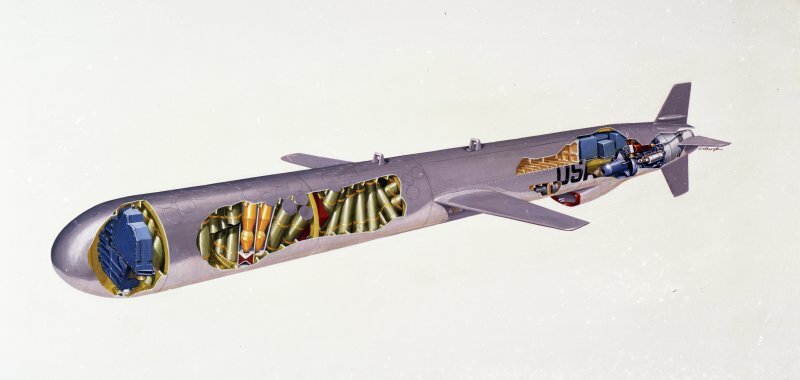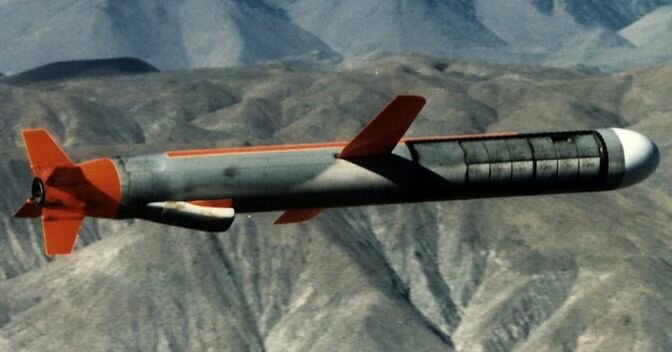You are using an out of date browser. It may not display this or other websites correctly.
You should upgrade or use an alternative browser.
You should upgrade or use an alternative browser.
AGM-109 dispenser
- Thread starter CIC-TAO
- Start date
- Joined
- 16 April 2008
- Messages
- 9,544
- Reaction score
- 14,285
Don't see this very often -- USAF MRASM (probably AGM-109H?). Obviously a runway attack version but the precise submunition used isn't obvious to me. There were quite a few candidates. The final winner was the Boosted Kinetic Energy Penetrator but this looks like something else. Maybe the German STABO?
Just a guess but I think that's just conceptual. The actual missile ejects it submunitions to the side.Does anyone know the exact model?
(0:34)
STABO is pretty big for a submunition. Probably too big in this orientation. (Significantly longer than the diameter of the missile.)Don't see this very often -- USAF MRASM (probably AGM-109H?). Obviously a runway attack version but the precise submunition used isn't obvious to me. There were quite a few candidates. The final winner was the Boosted Kinetic Energy Penetrator but this looks like something else. Maybe the German STABO?

DEU - STABO : Cluster Bombs and Submunition
Technical-tactical data
Weight: 17 kg
Dimensions:
- diameter of 132 mm
- length: 603 mm (without front cover 580 mm)
- Joined
- 16 April 2008
- Messages
- 9,544
- Reaction score
- 14,285
Oh, right. Thanks. Same issue rules out BKEP.
Possibly it was the Lawrence Livermore Tactical Airfield Attack Munition (TAAM), about which very little has been written. I only know it existed from the discussion of MRASM versions and possible payloads in this official cruise missile history (starting at page 205).
The relevant excerpt:
Possibly it was the Lawrence Livermore Tactical Airfield Attack Munition (TAAM), about which very little has been written. I only know it existed from the discussion of MRASM versions and possible payloads in this official cruise missile history (starting at page 205).
https://media.defense.gov/2017/Apr/07/2001728474/-1/-1/0/B_0006_WERRELL_EVOLUTION_CRUISE_MISSILE.PDF
The relevant excerpt:
The MRASM differed from the strategic cruise missile in three ways: requiring much less range, a terminal guidance system, and a different munition. The demands of range and accuracy appear to be well in hand. The technology to get a cruise missile hundreds of miles within hundreds of feet of a target, with TERCOM, and then within tens of feet of the target, with terminal guidance (DSMAC or SMAC), is both available and demonstrated. The developer's biggest problem centers on the munition, which according to the aviation press is the reason for the conservative schedule. The concept is to crater the runway and taxiway at 2,000-foot intervals. The MRASM can carry 50 to 80 submunitions totaling up to 1,000 pounds of payload.
Beginning in 1976, the United States and Great Britain jointly developed such a munition, the JP-233 runway buster. "Was" is the key word, because in early 1981 Congress decided the United States should withdraw from the program, primarily because of cost, much to the chagrin of the Air Force. The JP-233 contains cratering and delayed action mines as well as antipersonnel devices. The RAF used it in the 1982 Falkland Islands campaign. [NOTE: This is incorrect; JP.233 was not employed in the Falklands.]
Other runway-busting munitions under development included the Lawrence Livermore Laboratory's tactical airfield attack munition (TAAM). It is a 3.35-inch diameter, 13-pound, two-charge munition fitted into mortar tubes. The cruise missile discharges 60 to 80 of these devices, each retarded by a parachute before detonation. But the US military cancelled TAAM because of technical problems in July 1982. The Germans demonstrated the same type of weapon, the STABO, to American authorities at Eglin AFB in September 1982. The German STABO also uses a two-charge system, as does a similar munition - the boosted kinetic energy penetrator (BKEP) - under development by the Air Force Armament Division. After release from MRASM, a rocket charge in the BKEP drives a steel spike through the runway concrete where it explodes and creates a large crater. The Air Force MRASM can carry 28 BKEPs or 30 STABOs. Other munitions considered for this role include the 70-pound BLU-81 Grasshopper, the 16-pound Martin Dual Charge, and the 45-pound cluster airfield denial munition (CADM). But to knock out a 240-foot-wide runway may require multiple sorties (the kill probability of a 15-shot load of BLU-81s is .5, a 40-shot load of Martin Dual Charge is .6, and a 20-shot load of CADM is .3). The Air Force narrowed its attention to the STABO and BKEP, and conducted a direct competition in September 1982 to choose between the two. In February 1983, the JCMPO recommended purchase of the BKEP.
Last edited:
- Joined
- 3 June 2006
- Messages
- 3,086
- Reaction score
- 3,905
FYI, SDASM uploaded a few pictures showing early tests of the AGM-109 MRASM with Boosted Kinetic Energy Penetrator (BKEP) munition to their flickr archive.
Here an appetiser, where only the front section of the Tomahawk with the BKEP munition is tested.
View: https://flic.kr/p/2pWzQeY
Here an appetiser, where only the front section of the Tomahawk with the BKEP munition is tested.
View: https://flic.kr/p/2pWzQeY
Hah! Just stumbled onto this on the Flickr archive about an hour ago.FYI, SDASM uploaded a few pictures showing early tests of the AGM-109 MRASM with Boosted Kinetic Energy Penetrator (BKEP) munition to their flickr archive.
Here an appetiser, where only the front section of the Tomahawk with the BKEP munition is tested.
View: https://flic.kr/p/2pWzQeY
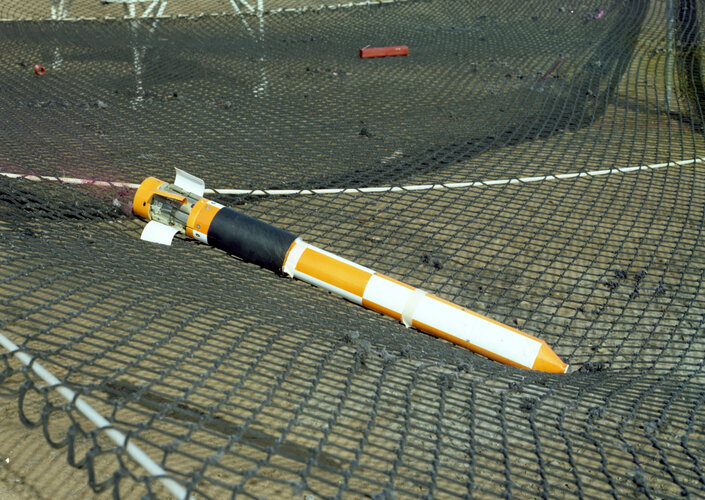
Tomahawk missile fan
ACCESS: Restricted
- Joined
- 19 September 2022
- Messages
- 43
- Reaction score
- 58
Very intresting Tomahawk Cruise Missile Video.
View: https://youtu.be/WyeMyhKE5Yw?si=tOvXimu6zrjZLPDS
- Joined
- 3 June 2006
- Messages
- 3,086
- Reaction score
- 3,905
FYI, SDASM uploaded a few pictures showing early tests of the AGM-109 Tomahawk Dispenser (MRASM) with Boosted Kinetic Energy Penetrator (BKEP) munition to their flickr archive.
Here two appetisers.
View: https://flic.kr/p/2qzyxux
View: https://flic.kr/p/2qzyxvz
Here two appetisers.
View: https://flic.kr/p/2qzyxux
View: https://flic.kr/p/2qzyxvz
- Joined
- 16 April 2008
- Messages
- 9,544
- Reaction score
- 14,285
FYI, SDASM uploaded a few pictures showing early tests of the AGM-109 Tomahawk Dispenser (MRASM) with Boosted Kinetic Energy Penetrator (BKEP) munition to their flickr archive.
Here two appetisers.
View: https://flic.kr/p/2qzyxux
View: https://flic.kr/p/2qzyxvz
Much appreciated!
One quibble: We know these submunitions aren't BKEP, since that is about twice as long as the diameter of the missile and the tubes are arranged crosswise. I think this is the Lawrence-Livermore TAAM from post #5, before they swapped to the much larger BKEP, which was stowed lengthwise in the missile.
The sketch in post #1 seems to be the basis for this painting.
Tomahawk missile fan
ACCESS: Restricted
- Joined
- 19 September 2022
- Messages
- 43
- Reaction score
- 58
- Joined
- 16 April 2008
- Messages
- 9,544
- Reaction score
- 14,285
Oh, right. Thanks. Same issue rules out BKEP.
Possibly it was the Lawrence Livermore Tactical Airfield Attack Munition (TAAM), about which very little has been written. I only know it existed from the discussion of MRASM versions and possible payloads in this official cruise missile history (starting at page 205).
https://media.defense.gov/2017/Apr/07/2001728474/-1/-1/0/B_0006_WERRELL_EVOLUTION_CRUISE_MISSILE.PDF
The relevant excerpt:
Before and after photos of some testing for the TAAM, courtesy of SDASM. Looks like an effects test, with the munition being dropped down the inclined rig into a concrete slab, which is broken up in the second image.
View: https://www.flickr.com/photos/sdasmarchives/54254601458/in/photostream/
View: https://www.flickr.com/photos/sdasmarchives/54254608584/in/photostream/
- Joined
- 3 June 2006
- Messages
- 3,086
- Reaction score
- 3,905
Here an interesting thread at X (fka twitter):
View: https://x.com/heatloss1986/status/1877579295616545015?t=z2MP5ZtPw6iNhzDH1nH0ZQ&s=19
Edit:
Here all the text form this interesting thread. Most of the pictures featured in that thread are from the SDASM flickr archive.
@heatloss1986 said:During the development of the Tomahawk Cruise missile, an airfield attack version was proposed.
This was to utilize runway-cratering submunitions as an alternative to manned missions or nuclear strikes to disable a Soviet airfield in a war. This was MRASM BKEP, or AGM-109H.
MRASM BKEP was a sub-variant of MRASM, which itself was a subvariant of Tomahawk. AGM-109H (Photo 4) should also be distinguished from the AGM-109 variant proposed to compete with the Boeing AGM-86 (Photo 3) and the shorter tactical AGM-109L (Photo 2).
MRASM as a concept started life in the late 1970s, as a joint program between the USAF and USN. It was mostly ignored until 1980, when Boeing won the Air Launched Cruise Missile competition with the AGM-86. Though AGM-86 was better for the role, AGM-109 offered unique advantages.
These advantages were primarily with the large payload capacity and high modularity inherent in the Tomahawk's design, and the fact that most of the R&D for the complicated portion (the missile and guidance options) had already been completed.
Until early 1981, the US had involved itself in JP233 development. JP233 was a dispenser used by RAF Tornados, which combined runway cratering munitions and anti-personnel bomblets.
Due to the withdrawal of the US from this program, an equivalent capability had to be procured.
Years later, in the Gulf War, the Tornados with JP233 assigned to hit airfields took severe losses to a less advanced air defense system than was employed by the Soviets in Europe.
MRASM airfield attack offered a far more survivable unmanned solution.
MRASM required much higher accuracy than most other Tomahawk land attack variants. For this reason DSMAC (digital scene matching) guidance was chosen.MRASM did not need the long range of the ground launched versions, so front sections could be filled with more submunitions.MRASM required much higher accuracy than most other Tomahawk land attack variants. For this reason DSMAC (digital scene matching) guidance was chosen.MRASM did not need the long range of the ground launched versions, so front sections could be filled with more submunitions.
The original versions of MRASM utilized ~60-80 of Lawrence Livermore National Laboratory's tactical airfield attack munition (TAAM). TAAM was a small cluster munition that would be deployed in patterns to damage the surface of the runway.
TAAM was cancelled in 1982.
After this, development refocused on one of two much larger and more powerful submunitions: the German STABO and the Air Force Armament Division's BLU-106 BKEP, or Boosted Kinetic Energy Penetrator.
This change in munition necessitated a change in munition storage and dispensing.
Unlike TAAM, BKEP and STABO had to be stored and released horizontally. This required some new R&D.
STABO appears to have been the initial focus, though this remains unclear. The fourth image shows what I believe to be STABO being deployed from a MRASM.
Development quickly moved to focus on BKEP. Like STABO, it was slowed by a parachute upon release from the MRASM, and upon reaching a high nose-down angle, would ignite its rocket, punch through the concrete, and detonate.
The crater caused by BKEP would prevent easy repairs.
Submunitions were rolled out of the side of MRASM at different intervals down the runway, to ensure that the runway was thoroughly damaged.
Though this thread is primarily about MRASM BKEP, I would be remiss if I did not mention the other ideas the USAF had for MRASM.The USAF had interest in using the low-flying, low-RCS Tomahawk for not only airfield attack, but also air defense destruction.
Combined Effects Bomblets, a shaped charge, fragmenting and incendary submunition, was planned for use on MRASM and tested against softer targets, though it could have been used for anti-tank.Carrying around 300 CEBs, MRASM would have carried more CEBs than two AGM-154A JSOWs.
Unfortunately, despite the success in testing, MRASM suffered from being a joint program that neither the USN or USAF particularly wanted, and the two bespoke versions for the different services were wildly different.
Cancellations of certain versions led the USN to withdraw from the program in 1982 and pursue their own modifications of Harpoon, primarily due to the high cost of MRASM.In 1984, the USAF would withdraw from the program themselves.
After this cancellation, the USAF adopted the Matra Durandal (in essence a larger BKEP) as the BLU-107 to be carried on the F-111 and F-15E. Like the Tornados of the Gulf War, these would have taken extremely high losses to Soviet IADS, unlike the expendable MRASM.
Last edited:
Similar threads
-
-
UK Requirements: SR(A) 1236 CASOM
- Started by overscan (PaulMM)
- Replies: 12
-
Cancelled AGM-65 Maverick projects
- Started by AN/AWW-14(V)
- Replies: 18
-
1980s US intercontinental cruise missile (& ATCM program)
- Started by GeorgeA
- Replies: 37
-

